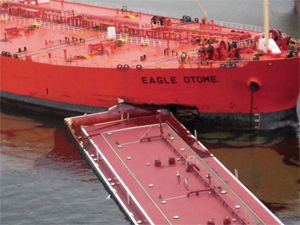The 2010 collision and spill involving the tanker Eagle Otome was caused by uncontrolled sheering and pilot fatigue, the National Transportation Safety Board (NTSB) has concluded.
The 810-foot tanker exited the Sabine-Neches Waterway, struck a docked cargo ship and then rebounded into the path of a tugboat pushing two barges. The lead barge carved a gash in Eagle Otome's cargo hold, spilling 462,000 gallons of oil into the waterway at Port Arthur, Texas, on Jan. 23, 2010.
 |
|
A tank barge pierced the hull of the 810-foot Eagle Otome at Port Arthur in 2010. Investigators said uncontrolled sheering caused the tanker to cross the path of the oncoming tow. (Photo courtesy U.S. Coast Guard) |
After mistiming a course change, Eagle Otome strayed to port and bounced off the moored Gull Arrow as the tug Dixie Vengeance approached with barges, the NTSB said in its September 2011 report. NTSB investigators said the two pilots aboard the tanker didn't follow their own policies and that the pilot at the conn was sleep-deprived.
"The probable cause … was the failure of the first pilot, who had navigational control of the Eagle Otome, to correct the sheering motions that began as a result of the late initiation of a turn at a mild bend in the water," the NTSB wrote.
"Contributing to the accident was the first pilot's fatigue, caused by his untreated sleep apnea and his work schedule, which did not permit adequate sleep," the report said.
The same pilot was distracted by a radio call, which investigators said should have been handled by the second pilot. Both pilots displayed "a lack of effective bridge resource management," according to the NTSB.
Investigators concluded that the first pilot had cumulative sleep loss following previous nighttime assignments and extended wakefulness, and his circadian rhythms were disrupted.
The Sabine Pilots Association and American Pilots' Association (APA) vehemently disagreed with the NTSB's findings. The local association's president, Capt. Duane Bennett, said fatigue played no factor in the incident. Bennett attributed the incident to an unanticipated behavior involving Eagle Otome in relation to the contour of the channel. He said the investigators should have focused on the hull design and hydrodynamics.
In a December 2011 letter to the NTSB, the APA said the investigative report should have focused on the use of assist tugs in the waterway.
Both associations noted that the pilot had more than 18 hours of rest, including more than 12 hours of sleep, prior to the Eagle Otome job.
"This was not a fatigue accident, and the evident determination to force this into the fatigue category devalues the report in the eyes of mariners and other maritime professionals," the APA wrote.
"Pilots and other experienced maritime professionals who are familiar with the facts of this casualty are virtually unanimous in the judgment that active tug assistance in circumstances similar to those that existed on the day of the casualty would be a valuable preventive measure," the APA said.
The channel at Port Arthur is 400 feet wide and is maintained to a depth of 40 feet. The Sabine Pilots can guide ships with a draft almost that deep through the waterway. Indeed, they use the small clearance to their advantage, said Capt. Charles Tweedel, who was the association's presiding officer at the time of the accident.
"We use the so-called 'bank effect' – the hydraulic reaction of the ship in proximity with the bottom and sides of the channel to help us make the ship go where we want it to go," Tweedel said. "It allows us to run really close to the bottom."
Eagle Otome didn't behave the way the pilots expected. "In this case, the bank effect was not able to control the ship," Bennett said.
The NTSB report noted that Eagle Otome's master accidentally pressed the engines' emergency stop button just as the ship was about to strike the moored Gull Arrow. The investigators concluded that shutting down power at that moment was not a factor in the crash, because the tanker would have hit the docked cargo ship anyway.
Mike Elsom, a spokesman for Eagle Otome operator AET Tankers, said the company "has nothing to add to the findings" of the investigators.
"As a responsible company with vessels that frequently transit these waters, AET did not wait until the findings of the NTSB were published to seek improvements to its operations (including) the adoption of a new transit policy in the Sabine-Neches waterway that sees all our vessels operating with tug assistance."
As a result of the spill, AET confirmed that it paid a fine of $400,000 to the Texas General Land Office. Texas officials said the money would be used to fund improvements to a Port Arthur park and to the Sabine Pass Battleground, a Civil War site.
Tweedel said the Sabine Pilots will write new policies governing the division of labor when two pilots are aboard a ship. The local policy document cited by the NTSB is actually an unofficial draft from 20-plus years ago that was never officially approved or implemented, the pilots said. All members are being sent to additional emergency ship handling training, and more assist tugs are now available.
"We are running bigger and bigger ships in the same ditch," Tweedel said. "Since the accident, we've added two more tractor tugs to the fleet in the harbor, and that doubles our tractor-tug assets, and I think that's a positive move."
